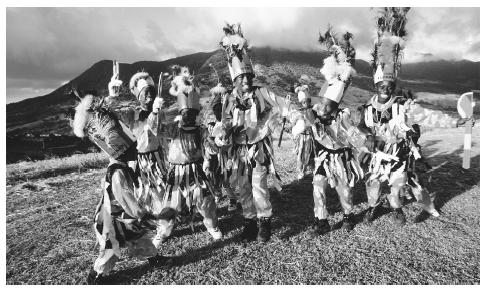Saint Kitts and Nevis has a rich cultural heritage rooted in African, British, and Caribbean traditions, shaped by its colonial past and African ancestry. The islands celebrate this through festivals, music, storytelling, food, religion, and social customs. Here’s a breakdown of key cultural practices:
1. Carnival & Cultural Celebrations
- National Carnival (Sugar Mas) – Held in Saint Kitts from December to January, with calypso competitions, street parades, costume bands, steel pan music, and more.
- Culturama (Nevis) – Celebrated in late July–early August, this is Nevis’ main cultural festival, showcasing traditional dress, dance, music, and folklore.
- J’ouvert – Early morning street party featuring mud, paint, and music, part of Carnival festivities.
2. Music & Dance
- Popular genres: Calypso, Soca, Reggae, Dancehall, Steel Pan, and Gospel
- Traditional music forms like Big Drum and String Band Music are still performed, especially on Nevis.
- Dance styles include:
- Masquerade dancing (colorful costumes, tall peacock feathered headdresses)
- Quadrille dancing (influenced by European colonial dance, now adapted into folk form)
3. Food Traditions
- Food is central to celebrations and family life.
- Popular cultural dishes:
- Goat water stew (national dish)
- Saltfish with dumplings and coconut-fried plantains
- Conkie (cornmeal dessert steamed in banana leaves)
- Meals are often communal and served at family gatherings, religious functions, or community events.
4. Religion & Spiritual Practices
- Christianity is the dominant religion (Anglican, Methodist, Pentecostal, Catholic).
- Church services are important community events, often with music, hats, and formal wear.
- Religious holidays like Easter, Christmas, and Emancipation Day are deeply respected and celebrated.
- Elements of African spirituality and ancestral respect still influence family rituals and values.
5. Family & Community Values
- Families tend to be close-knit, with strong respect for elders and multigenerational households.
- Community cooperation is emphasized, especially in rural areas (e.g., sharing food, helping with farming or home building).
6. Storytelling & Folklore
- Oral tradition plays a big role in passing down folklore, proverbs, and family history.
- Folk tales often involve characters like Br’er Anansi (a trickster spider), and stories carry moral lessons.
7. Traditional Clothing & Craft
- Madras fabric is often used for cultural wear during festivals.
- Women wear headwraps, pleated skirts, and blouses with lace for folk dances or special occasions.
- Handicrafts include:
- Basket weaving
- Pottery
- Wood carving
- Jewelry made from shells and natural materials
8. Emancipation Day & Heritage Week
- Emancipation Day (first Monday of August) celebrates the abolition of slavery with re-enactments, drumming, and dances.
- Heritage events promote the preservation of local history, from sugar plantations to African roots.
9. Funeral & Mourning Customs
- Funerals are both somber and celebratory, often involving large family gatherings, music, and community support.
- Nine-night or wake ceremonies (originating from African traditions) are held in some cases, with food, singing, and storytelling.
10. Respect for Elders & Social Etiquette
- Elders are deeply respected in both speech and actions.
- Greetings are very important (e.g., “Good morning,” “Good afternoon”).
- Hospitality is a valued practice — guests are often offered food or drinks when visiting a home.


